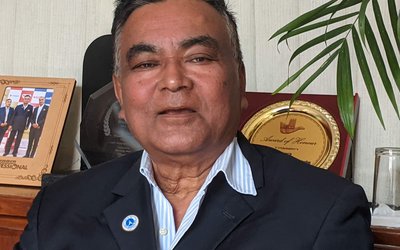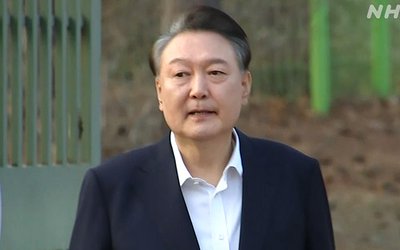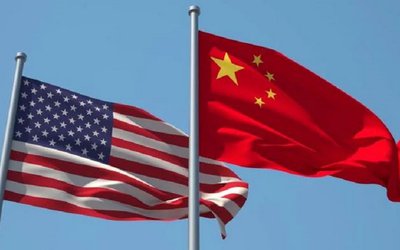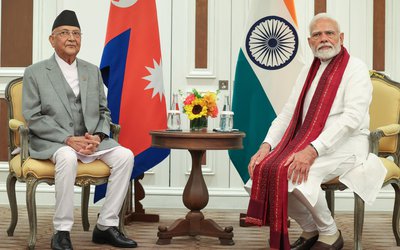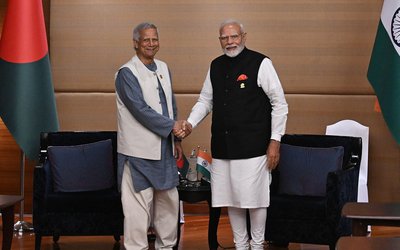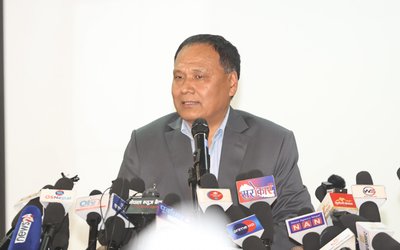
After working for more than three decades in the banking and development sectors, including service as a decentralization expert in United Nations in Afghanistan and Nepal, chief executive officer of Citizen Investment Trust, Ram Krishna Pokharel, who did his master's in agriculture from the Philippines University, is now leading a company with an aim to bring changes in the investment sector. A die-hard democrat, Pokharel is now developing a strategy to make the Trust as a major domestic investor in infrastructure development. Pokharel spoke to New Spotlight on various issues. Excerpts:
As CIT is celebrating 25 years of its presence, what strategy do you have to make the Trust more visible and strong in the coming days?
The Trust has learned many lessons in the last twenty-five years and we have still to do a lot of work. This quarter century is a lesson for the trust. The trust was established through a separate act in1991. This institution came into operation in January 1992. Initially, it started compulsory saving schemes for the employees and it was just a short term scheme of deposit. After the promulgation of income tax act 1999, which gives a lot of benefits, including tax rebate to depositors and they can get a tax rebate.
How do you see the volume of deposit?
The volume of deposit and institutions involved in the deposit scheme have gone up. Now along with government employees, Nepal Army, Nepal Police and government owned corporation, large numbers of depositors are from private sector, NGOs, INGOs and donor supported projects. Our largest depositors are from private sector which holds over fifty percent of our deposits and depositors. The private sector employees also include the labor class. Every individual whether he is permanent, temporary or contract, they can participate in the compulsory savings of the trust. It is impossible in other institutions. This avenue opens to CIT.
What plans do you have at hand?
We want to expand this. Ninety-nine percent of employees working in bilateral and multi-lateral agencies are sending their deposit here. We get deposits of all the banking staff. We are using all avenues given by act. After 2000, the saving increment of deposit has gone fast. Now, we have 67 billion rupees deposit which is around 700 million US dollar. In a short period of time, we were able to generate such a huge amount of money. This shows that CIT’s service delivery mechanism quickly drew the attention of wide public.
What about the long-term perspective plan?
Frankly speaking, CIT was unable to think with a long-term perspective. After taking the charge of CEO, I have come to realize that CIT is unable to make preparations for a long term investment. Now I am working to prepare a Five Years' Strategic Plan, which is going to be a roadmap of CIT. This is the first such document prepared in its history. We are launching the Five Year Strategic Plan shortly. It will show where CIT will be in the coming five years. Our plan is to double the present level of savings in the next five years.
What about investment?
So far as the investment of money is concerned, it is a huge challenge. Given the present scenario when private sector is not moving properly, it is very difficult. Although our act mandates us to invest our money in public companies, we cannot blankly invest money there because of the management challenges they have been facing including political interventions. We are looking for private sector companies which float their share in public. We can invest in companies in equity and debt. Our act opens us avenues for equity. We can even invest as promoters.
What is your target?
We have entered now in portfolio diversification agenda. Under this provision, we have invested in Upper Tamakosi Project for the first time. We have equity and debt part as well. Our equity is less than five percent. We have also the promoter share in HIDCL. We are promoting HIDCL to pave the way for hydropower development. In the present Nepalese context, industrial sectors are promising and we want to invest there. Our responsibility is towards the depositors and we need to protect their interests. We don’t want to invest money where the depositor's investment is in risk. Thus we consider very seriously before making any decision on investment.
Where do you want invest the money?
We want to invest the money in productive infrastructure which generates the revenues. The sector should be company model or Public Private Partnership Model. These are the new avenues we are opening for the CIT for the days to come. We want to invest in consortiums and joint ventures. Till now, we deposit our money in the fixed deposits of commercial banks as sixty five percent of our money is deposited in fixed accounts. We want to reduce it by thirty percent in coming five years. That means we want more money in investment. We want to see CIT’s investment to contribute in GDP significantly. We also want our investment generate the employment. We want to feel our investment from macro level to micro level. This is the reason we want to extensively diversify our investment.
What is in the strategic plan?
We have separated three business pillars in the strategic plan. Saving, investment and capital market. Under the saving scheme, we are given the role by government to cover accidental insurance to civil service, army, police, armed police and community teachers up to 100,000 rupees as social security. This is also a part of saving. Under this scheme, more than 300,000 individuals will be included. Although we are not an insurance company, CIT is simply a fund manager for that. On the condition of the government, we will refund the money. In case of fatality, they will receive 100,000 rupees. Saving portfolio is gradually increasing. We are also managing gratuity and pension for bankers and private companies and projects. We are also managing pension fund of non-governmental and semi-governmental offices. We will expand this. CIT will provide more services to the private sector’s employee social security scheme.
How do you see the possibility of collecting money outside the country?
As part the CIT Act, we are also authorized to collect the money collected by Nepalese working in abroad and invest them in foreign share market. We are doing feasibility studies and submitting our proposal to Nepal Rastra Bank to get an approval. We will launch this scheme soon. We are also playing the role of market maker of capital market. For the growth, stability and expansion of capital market, CIT needs to work as market maker. This is the provision included in act. We have entered into that. We have already initiated the process, submitting our proposal to the concerned regulatory body. Although capital market has grown, only two percent capital is in the market and ninety percent out of that. We can encourage big corporate houses and banks to enter the capital market. We will be there as a stock dealer. We will guarantee if somebody wants to come, we will buy the share. We have two types of depositors, private and government, which include about 700,000. Institutionally we have the company with largest depositors.
As you said you have such a big fund, have not you explored multilateral agencies for any kind of partnership?
For the first time, Nepal is constructing a hydropower project, 456 MW upper Tamakoshi, with internal resources. We have got the resources. What we are lacking is technical and managerial capacity. We have enough resources but not technical capability. CIT alone can fund up to 100 MW project annually. We have that capacity. We want to go for equity for national projects as a long term strategy partners. We are asking for equity partners. CIT’s experiences have shown that internal agencies are also capable to invest in smaller projects and the government does not need to go for borrowing money.
How do you see the role of CIT in rebuilding and reconstruction?
We can work in PPP modality for rebuilding and reconstruction. Finally, what we want is the project which will pay back money since our collection is public deposit. We are planning to support the housing plan. We are considering to support sub-urban areas. We are not discussing with some government agencies to launch the joint projects. We have already started initial work targeting low and middle income groups, supporting to construct earthquake resistant houses. We have already visited sites.
How do you see the contribution of private sectors?
Our larger contributors are the project staffs funded by INGOs, UN Agencies, bilateral and multilateral agencies. This has also contributed a huge saving in our volumes. As we have started from white color jobs, we are now moving to workers of small and medium scale enterprises. Our five year strategic plans also have schemes to bring them in our saving.
Have you invested money in the agriculture sector?
We are also working with smaller growers and producers. We are making efforts to work together with cooperatives. We are now planning to enter with Small Farmers Development Bank in the productive sector. Our target is to reach smaller growers, producers and farmers through the bank. We are also targeting the remittances market. Although we claim Nepal to be the richest country of the world in terms of hydropower, we just generate over 700 MW power. We have the capacity to buy the shares of projects. We want to invest our saving in competitive sectors like energy and agriculture. If we generate 20,000 MW, every people can have equity.
How do you distinguish CIT from other financial institutions?
We are not bankers and we are not retail depositors. We do deposit under a scheme and with the government and other employees. We also have a unique scheme for individuals to capital market. Anyone can buy, saving certificate up to Rs.1000.000 and receive 8 percent interest rate per annum. Nobody gives such interest. Employment Provident Fund is a fund of Nepal government’s employees. However, we can also include all sectors. CIT’s nature of work is semi government. Here people from all the sectors come to deposit. We need to make our services more effective. Our IT service is very weak and we are now making IT packages. We are discussing with companies from Singapore and Nepal.
Don’t you think this as a social welfare?
We recently opened a regional branch each in Pokahra and Birtangar. We are establishing three more branches to increase our outreach, Then, we can reach all the people.
- IME GROUP: Expands Into Paper Industry
- Mar 24, 2025
- CPN UML: Instigated By India
- Mar 23, 2025
- ADB’S CHIEF ECONOMIST: Nepal Reduces Poverty
- Mar 11, 2025
- FM DR. DEUBA: A Successful Visit
- Mar 11, 2025
- MD GHISING: Target Of Personal Grudge
- Mar 09, 2025





